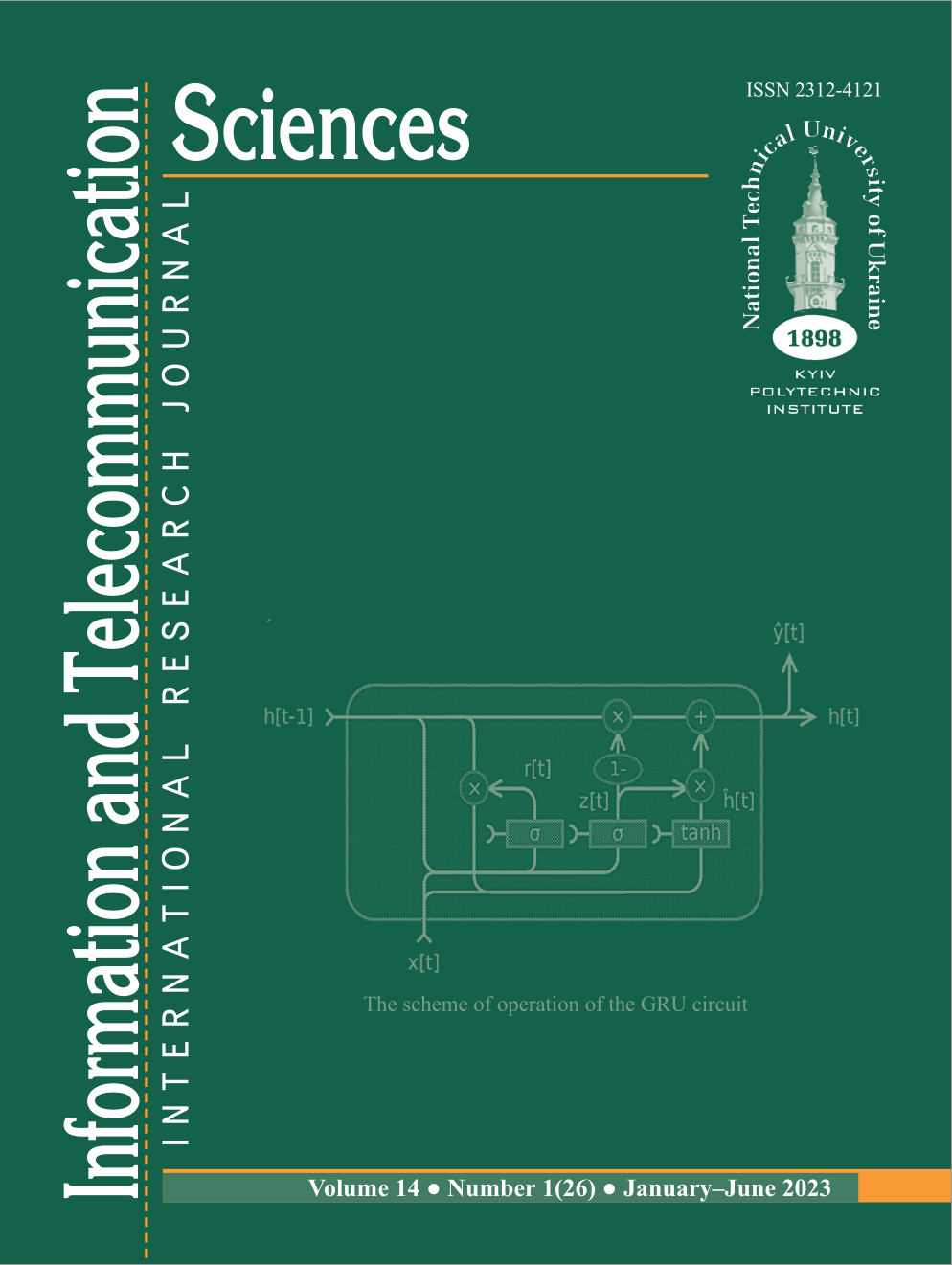INTERNET OF THINGS DATA TRANSFER METHOD USING NEURAL NETWORK AUTOENCODER
DOI:
https://doi.org/10.20535/2411-2976.12023.9-15Keywords:
Internet of things, data coding, neural network, autoencoder, training on the original model, data compressionAbstract
Background. The number of devices in the Internet of Things is constantly increasing. At the same time, the number of solutions on the market for such technologies is growing. Statistics confirm that these factors lead to an increase in data transfer volumes. This raises the number of resources spent on data transmission. The growing trend in the number of users of the Internet of Things technology leads to the emergence of the problem of a rapid increase in the data transmitted by the network.
Objective. The purpose of the paper is to improve the process of data transmission in the Internet of Things by modifying the neural network autoencoder to reduce network resources use.
Methods. Analysis of publications dedicated to Internet of things data transmission. Integration of existing data coding solutions based on a neural network autoencoder in the process of transmitting data from the Internet of things.
Results. The neural network autoencoder has been improved by using an algorithm that additionally includes an arithmetic encoder and further training a new model on the output of a full-fledged autoencoder.
Conclusions. The process of data transmission in the Internet of Things network has been modified by improving the neural network autoencoder by using the training of a smaller neural network on the initial data of the main autoencoder, which has reduced the amount of data transmitted and, accordingly, reduced the use of network resources.
References
Mashal, I.; Alsaryrah, O.; Chung, T.Y.; Yang, C.Z.; Kuo, W.H.; Agrawal, D.P. Choices for interaction with things on Internet and underlying issues. Ad Hoc Netw. 2015.
Madakam, S.; Ramaswamy, R.; Tripathi, S. Internet of Things (IoT): A literature review. J. Comput. Commun. 2015.
Sethi, P.; Sarangi, S.R. Internet of Things: Architectures, Protocols, and Applications. J. Electr. Comput. Eng. 2017.
M. Goyal, K. Tatwawadi, S. Chandak, I. Ochoa, Data Compression Conference (DCC), May 2019
Compressing BERT for faster prediction // Retrieved from https://blog.rasa.com/compressing-bert-for-faster-prediction-2/
Convert the sample JSON file from a tree to a table. // Retrieved from https://www.researchgate.net/figure/Convert-the-sample-JSON-file-from-a-tree-to-a-table_fig3_332591327
NN based lossless compression – DeepZip // Retrieved from https://github.com/mohit1997/DeepZip
D.D. Testa and M. Rossi, IEEE Signal Processing Letters, 2015.
L. Globa, V. Kurdecha, I. Ishchenko and A. Zakharchuk, "An approach to the Internet of Things system with nomadic units developing," 2017 14th International Conference The Experience of Designing and Application of CAD Systems in Microelectronics (CADSM), 2017, pp. 248-250, doi: 10.1109/CADSM.2017.7916127.
J. Yamnenko, L. Globa, V. Kurdecha and A. Zakharchuk, "Data Processing in IoT Systems based on Fuzzy Logics," 2019 Modern Electric Power Systems (MEPS), 2019, pp. 1-4, doi: 10.1109/MEPS46793.2019.9395055.
J. Yamnenko, V. Kurdecha and N. Gvozdetska, "Domestic Solid Waste Disposal Logistic Optimization Using Internet of Things Technologies," 2021 IEEE International Conference on Information and Telecommunication Technologies and Radio Electronics (UkrMiCo), 2021, pp. 1-5, doi: 10.1109/UkrMiCo52950.2021.9716596.
L. Globa, V. Kurdecha, I. Ishchenko, A. Zakharchuk and N. Kunieva, "The Intellectual IoT-System for Monitoring the Base Station Quality of Service," 2018 IEEE International Black Sea Conference on Communications and Networking (BlackSeaCom), 2018, pp. 1-5, doi: 10.1109/BlackSeaCom.2018.8433715
Skulysh M. Management of Multiple Stage Queuing Systems / M. Skulysh, S. Sulima // CADSM 2015 : 13-th International conference, 24–27 February 2015 : conference proceedings. — Lviv–Polyana, 2015. — pp. 431– 434.
G. Amrani, A. Adadi, M. Berrada, Z. Souirti and S. Boujraf, "EEG signal analysis using deep learning: A systematic literature review," 2021 Fifth International Conference On Intelligent Computing in Data Sciences (ICDS), 2021, pp. 1-8, doi: 10.1109/ICDS53782.2021.9626707.
I. V. Pustokhina, D. A. Pustokhin, D. Gupta, A. Khanna, K. Shankar and G. N. Nguyen, "An Effective Training Scheme for Deep Neural Network in Edge Computing Enabled Internet of Medical Things (IoMT) Systems," in IEEE Access, vol. 8, pp. 107112-107123, 2020, doi: 10.1109/ACCESS.2020.3000322.
S. Huang, Y. Guo, D. Liu, S. Zha and W. Fang, "A Two-Stage Transfer Learning-Based Deep Learning Approach for Production Progress Prediction in IoT-Enabled Manufacturing," in IEEE Internet of Things Journal, vol. 6, no. 6, pp. 10627-10638, Dec. 2019, doi: 10.1109/JIOT.2019.2940131..
M. U. Ndubuaku, M. K. Ali, A. Anjum, A. Liotta and S. Reiff-Marganiec, "Edge-enhanced analytics via latent space dimensionality reduction," 2020 IEEE/ACM International Conference on Big Data Computing, Applications and Technologies (BDCAT), 2020, pp. 87-95, doi: 10.1109/BDCAT50828.2020.00018.
Liu, C., Zhang, Y., Li, Z., Zhang, J., Qin, H., & Zeng, J. (2015). Dynamic Defense Architecture for the Security of the Internet of Things. 2015 11th International Conference on Computational Intelligence and Security (CIS). doi:10.1109/cis.2015.100


